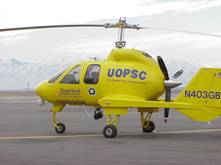Design and development
Design work on the Hawk utility/passenger autogyro began in 1996 and the first prototype, the two seat H2X, first flew on 4 February 1997. It was later modified to include a third seat and renamed the Hawk III. The production prototype, a four-seater named the Hawk 4, was significantly different from the Hawk III in detail but retained the pod and mid-line pusher engine configuration, combined with low stub wings, twin booms and fins. Changes between the Hawk III and 4, apart from cabin revisions to accommodate the extra seat, included a new constant chord, aluminium rotor in place of the earlier tapered, composite blade. The rotor was also lowered and the pitch control levers enclosed within a shallower fairing. The wings and fixed tailplane were cropped, so that they no longer extended beyond the booms and fins, the rudders were shortened so that the tailplane no longer needed cut-outs for their movement and extra, short, inboard rudders were added. Successive engine changes increased the power by almost a factor of two. [1] [2]
The Hawk 4 had a steel rotor mast and engine mountings but was mostly aluminium elsewhere, including the rotor, rotor head and propeller. The fuselage was an aluminium semi-monocoque. Some components, such as the nosecone, engine cowling and cabin door were formed from composite materials. The rotor was a semi-rigid or teetering design with a swash plate, rotating at up to 270 rpm. Yaw was jointly controlled by the balanced rudders on the endplate fins and the all-moving inboard rudders. It had a fixed, tricycle undercarriage with mainwheels mounted at the tips of the stub wings. Two rows of seats accommodated the pilot and up to three passengers; alternatively, the rear seats could be folded to provide baggage space. [2]
The Hawk 4 was powered by a 261 kW (350 hp) Continental TSIO-550 air cooled flat-six piston engine, which provided pre-rotation power to the rotor for jump starts and drove a four blade propeller in forward flight. The Hawk 4 first flew on 29 September 1999 and had logged 120 hours by the following April. [2] A second aircraft, initially designated Hawk 4T and powered by a 313 kW (420 hp) Rolls-Royce 250-B17C turboprop driving a three blade propeller first flew on 12 July 2000. It was redesignated Hawk 4 when development of the piston engine version was dropped. [3] It had a taller undercarriage, high set tailplane, endplate fins with rounded extensions below the tailbooms and modifications to the inboard rudders. The Hawk 5 was a planned five seat development. Despite optimistic sales predictions before the 2000 recession, the Hawk did not reach production. [3]
This page is based on this
Wikipedia article Text is available under the
CC BY-SA 4.0 license; additional terms may apply.
Images, videos and audio are available under their respective licenses.
